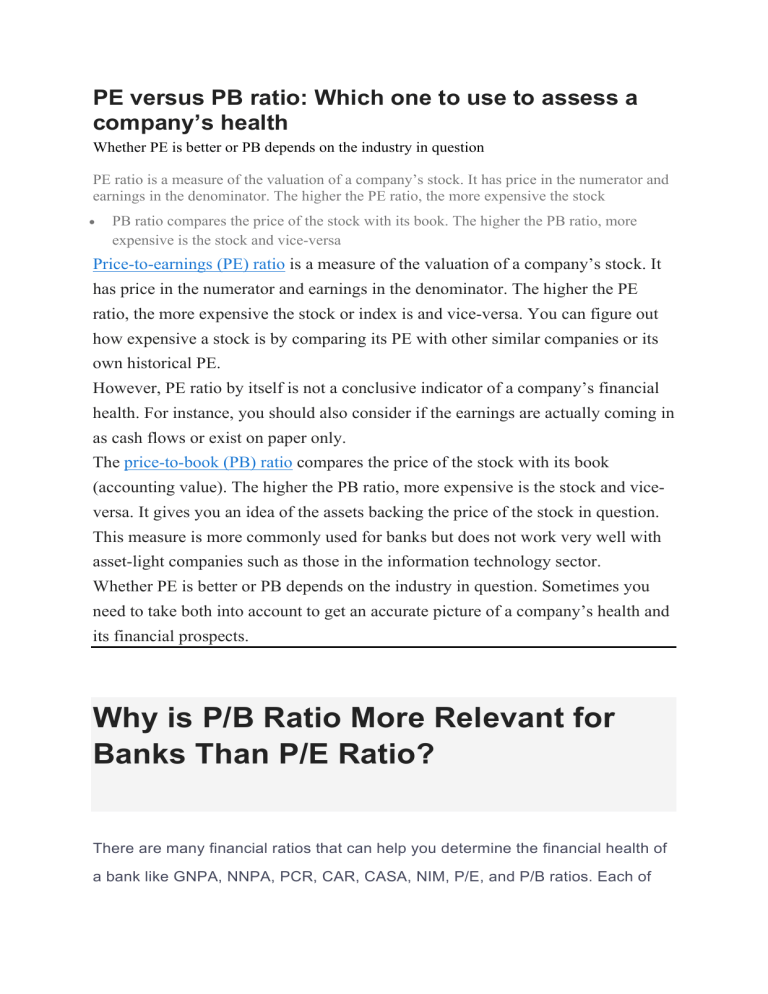
PE versus PB ratio: Which one to use to assess a company’s health Whether PE is better or PB depends on the industry in question PE ratio is a measure of the valuation of a company’s stock. It has price in the numerator and earnings in the denominator. The higher the PE ratio, the more expensive the stock PB ratio compares the price of the stock with its book. The higher the PB ratio, more expensive is the stock and vice-versa Price-to-earnings (PE) ratio is a measure of the valuation of a company’s stock. It has price in the numerator and earnings in the denominator. The higher the PE ratio, the more expensive the stock or index is and vice-versa. You can figure out how expensive a stock is by comparing its PE with other similar companies or its own historical PE. However, PE ratio by itself is not a conclusive indicator of a company’s financial health. For instance, you should also consider if the earnings are actually coming in as cash flows or exist on paper only. The price-to-book (PB) ratio compares the price of the stock with its book (accounting value). The higher the PB ratio, more expensive is the stock and viceversa. It gives you an idea of the assets backing the price of the stock in question. This measure is more commonly used for banks but does not work very well with asset-light companies such as those in the information technology sector. Whether PE is better or PB depends on the industry in question. Sometimes you need to take both into account to get an accurate picture of a company’s health and its financial prospects. Why is P/B Ratio More Relevant for Banks Than P/E Ratio? There are many financial ratios that can help you determine the financial health of a bank like GNPA, NNPA, PCR, CAR, CASA, NIM, P/E, and P/B ratios. Each of these ratios provides certain insights into the bank’s financial strength. Today, we are going to focus on two commonly used financial ratios – P/E and P/B and look at the reasons that make P/B ratios more relevant to banks than P/E ratios. What are The P/E Ratio and P/B Ratio? The market price of the share of a company is an indicator of the way investors perceive it. If the investors feel that a company holds a lot of promise and can grow and earn good profits in the future, then they would want to buy its shares leading to an increase in its price. On the other hand, if a company is perceived to be in troubled waters, then investors tend to stay away and sell its stocks. While the market price of a share does not directly indicate the strength of the company, it is an indicator of the market’s perception. 1. P/E Ratio When you plan to buy a stock, you need to assess the company’s fundamentals and investor perception to make an informed decision. This is where the P/E Ratio helps. A P/E or Price to Earnings Ratio is the ratio of the market price of a company’s stock to its earnings per share (EPS). In other words, P/E Ratio = Market PriceEarning Per Share It indicates how much money an investor has to invest in the company to earn Re.1 of the company’s earnings. So, if the P/E Ratio of a company is 25, then you need to invest Rs.25 in the said company to earn one rupee of its earnings. 2. P/B Ratio While the P/E Ratio is based on the company’s earnings, the P/B ratio takes its book value instead. Book Value of a company is the net value of all its assets after deducting all liabilities. In other words, Book Value = Total Assets-Total Liabilities A P/B or P/BV or Price to Book Value Ratio is the ratio of the market price of a company’s stock to its book value per share (BVPS). In other words, P/B Ratio = Market PriceBook Value Per Share (BVPS) BVPS is the accounting value of each share of a company and is calculated as follows: BVPS = (Total Shareholder Equity-Preferred Equity)Total Outstanding Common Shares It indicates the amount of money an investor has to invest for the net assets of the company. Since the market value of a share is usually higher than its book value, the P/B is typically greater than 1. A high P/B Ratio is an indicator that investors expect the management of the company to generate more value from the given assets. Which Is More Relevant For Banks: P/E Ratio or P/B Ratio? Around the world, a P/B Ratio is a more popular measure of valuation of a bank and/or financial services company compared to a P/E Ratio. Here are some reasons that make it more relevant: 1. It Helps Understand The Efficiency Of Fund Utilization When you look at the P/B Ratio of a company, a low value usually indicates an undervalued stock and vice versa. However, the significance of the P/B Ratio changes for banks. When we look at the banking sector, all banks have a nearly similar impact of macroeconomic conditions like the inflation rate, liquidity, interest rate, etc. However, if you are comparing banks and want to identify the better-performing ones, then you need to focus on how efficiently one bank is utilizing its funds or assets over others. A P/E Ratio offers an understanding of the market value of a stock with respect to its earnings. On the other hand, a P/B Ratio allows you to assess the valuation of the stock of the company with respect to its book value. Hence, it offers a perspective of the performance of the company with respect to the efficiency with which the funds were utilized. This is particularly beneficial while analyzing the performance of a bank where optimal utilization of funds plays an important role in its success. 2. A Good Indicator Of Bank Spread When you compare the financial performance of banks, assessing the bank spread is important. For most banks, the yield and cost of funds are similar. Hence, when a P/B Ratio is calculated, it depends upon the bank’s spread and its ability to keep the non-performing assets (NPAs) under control. Further, as per Basel requirements, banks need to maintain a specific capital adequacy ratio which is a percentage of their assets. Since a P/B Ratio is based on the book value, it is a good alternative for yields on assets. 3. Offers A Picture Of A Bank Even If It Is Making Losses A P/E Ratio makes sense only when a company is making profits. During lossmaking periods since there are no earnings, this ratio becomes irrelevant. If you look at the loss-making banks, it is easy to observe that many such banks can be turned profitable by creating supporting conditions for spread. Further, banks have a long investment and gestation period. Hence, a P/B ratio is a better metric to assess the bank’s performance. P/B Ratio + ROE In banks, the P/B Ratio is the primary measure of valuation. However, you should not rely on this ratio alone to assess the financial health of a bank. When you use P/B Ratio in conjunction with ROE or Return on Equity Ratio, you can get a more effective analysis. This is because ROE + P/B Ratio offers a better insight into the growth prospects of the bank. An ROE Ratio that increases in tandem with the P/B Ratio is usually an indicator of a healthy company. Summing Up While a P/B Ratio is more relevant than P/E Ratio for analyzing a bank, you need to ensure that you assess the bank by considering different parameters. Every industry is unique. Remember to look at the bank from all other aspects as well. No parameter should be used in isolation. Since banks have specific regulations and restrictions, it is important to compare them using the right parameters. Remember, your focus should be to conduct a thorough analysis of the bank. Happy Investing!




